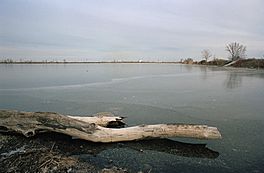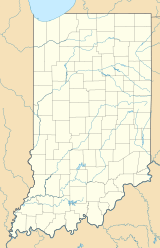Wolf Lake (Indiana–Illinois) facts for kids
Quick facts for kids Wolf Lake |
|
|---|---|
 |
|
| Location | Hegewisch, Chicago, Illinois and Hammond, Indiana |
| Coordinates | 41°39′57″N 87°31′39″W / 41.66583°N 87.52750°W |
| Primary outflows | Indian Creek into Calumet River |
| Basin countries | United States |
| Managing agency | Hammond Port Authority and Illinois Department of Natural Resources |
| Surface area | 804 acres (325 ha) (total) 385 acres (156 ha) (Indiana) 419 acres (170 ha) (Illinois) |
| Average depth | 5.95 ft (1.81 m) (overall) 4.80 ft (1.46 m) (Indiana) 6.64 ft (2.02 m) (Illinois) |
| Max. depth | 18.2 ft (5.5 m) (Indiana) 18.4 ft (5.6 m) (Illinois) |
| Water volume | 5,573 acre⋅ft (6,874,000 m3) (total) 2,743 acre⋅ft (3,383,000 m3) (Indiana) 2,830 acre⋅ft (3,490,000 m3) (Illinois) |
| Residence time | 0.58 years |
| Shore length1 | 24.77 mi (39.86 km) (total) 12.34 mi (19.86 km) (Indiana) 12.43 mi (20.00 km) (Illinois) |
| Surface elevation | 584 ft (178 m) |
| 1 Shore length is not a well-defined measure. | |
Wolf Lake is a large lake that covers about 804 acres. It sits right on the border between Indiana and Illinois, not far from Lake Michigan. The lake is smaller now than it used to be. This is because people filled in parts of its edges to build things.
Even with some past environmental damage from factories, roads, and city runoff, Wolf Lake is still a very important place for nature in the Chicago area. It is home to many different kinds of plants and animals.
The lake is located between Hammond, Indiana and the Hegewisch area of Chicago, Illinois. It used to have a channel that connected it to Lake Michigan in Indiana. However, this channel was closed off for building projects. Today, there are plans to open this connection again.
The Illinois part of Wolf Lake has five connected sections. These are separated by walls called dikes. These dikes were built in the late 1950s. They allowed parts of the lake to be drained. This helped get dirt to use for building the Chicago Skyway. The western sections of the lake are now part of the William W. Powers State Recreation Area. Water from these parts flows into Indian Creek, which then goes to the Calumet River.
The Indiana part of the lake has three connected sections, also separated by dikes. A long dike, which runs next to State Line Road, holds railroad tracks. The Indiana Toll Road (Interstate 90) also crosses through the middle of the lake in Indiana. Several other railroad paths cross the lake, though some are no longer used.
Many areas around the lake are now parks or nature preserves. This includes the Eggers Woods area, which is part of the Forest Preserve District of Cook County. Some industrial businesses and homes are also located near the lake.
Wolf Lake is close to other lakes like Lake George, Lake Calumet, and Powderhorn Lake. There was once another lake called Hyde Lake to the west, but it was filled in. Only a small swampy area remains of it today.
Contents
History of Wolf Lake
Wolf Lake has a long history, going back over 150 years. The exact reason for its name is not fully known. Famous people like Abraham Lincoln even visited the lake. It is said that Mary Todd Lincoln almost drowned there once.
In 1924, a historical event happened near the lake. The body of a young boy named Bobby Franks was found in a culvert (a tunnel for water) northwest of the lake. This discovery was part of a very famous court case at the time.
From 1933 to 1936, a race track called Wolf Lake Speedway was built inside the lake in Hammond, Indiana. A part of the lake was drained so the track could be constructed. It was completely surrounded by the lake's water.
Cold War Missile Site
During the Cold War, two areas around Wolf Lake were used for a special defense system. This system was called Nike missile site C-44. It was part of a network of sites built to protect Chicago and its factories from air attacks. These sites formed a ring of defense around the city.
Both missile site areas were closed down in the 1970s. Since then, they have been turned into places for nature and recreation. On the northwest side of the lake, a large area of wetlands was filled in to build the missile site. This area is now Eggers Woods, a part of the Cook County Forest Preserve. The southwest side of the lake held the radar station for the missiles. This area is now the William W. Powers State Recreation Area in Illinois.
Ecology of Wolf Lake
Wolf Lake and the lakes nearby were once some of the most diverse natural places in the Midwest. About 80 years ago, a famous naturalist named Donald Culross Peattie said Wolf Lake was one of North America's best natural areas. He noted its amazing collection of water plants and wildlife. It is still a very unique and diverse place today.
In 2002, over 150 experts gathered at Wolf Lake for an event called the Calumet Bioblitz. For 24 hours, they worked to find and record as many living things as possible. This included plants and animals in the lake, forests, prairies, and marshes. The goal was to show how much amazing nature still exists in the urban and industrial landscape south of Chicago.
The water level in Wolf Lake was about 18 inches higher until 1998. That year, the Illinois Department of Natural Resources removed some beavers and their dams from Indian Creek. The lower water level led to more weed growth and changed fishing conditions. However, there are signs that beavers are back on the lake now.
Fish in Wolf Lake
Wolf Lake is home to some special fish. It has the endangered Lake sturgeon (Acipenser fulvescens). It also has the threatened Banded killifish (Fundulus diaphanus).
Birds of Wolf Lake
The lake and its nearby wetlands are important nesting spots for several bird species. These include the endangered black-crowned night heron, little blue heron, yellow-crowned night heron, and yellow-headed blackbird.
You can also find different kinds of swans on the lake in winter. Native Trumpeter swans (Cygnus buccinator) and Tundra swans (Cygnus columbianus) visit. Non-native Mute swans (Cygnus olor) are also present. Tundra swans fly north to the arctic to nest in summer. However, Mute swans stay in the area all year. They compete with the native Trumpeter swans for living space. This makes it harder to bring back more native Trumpeter swans around the Great Lakes.
Plants of Wolf Lake
The wetlands near Wolf Lake are home to rare plants. These include the endangered false golden sedge (Carex garberi) and little green sedge (Carex viridula). The threatened marsh speedwell (Veronica scutellata) also grows there. One of the most amazing things about the lake is its wide variety of rare water plants.
Restoring the Wolf Lake Ecosystem
A big project was completed in September 2007 to help restore Wolf Lake. This project cost $7.25 million. It was led by the Chicago District of the U.S. Army Corps of Engineers, with help from the Illinois Department of Natural Resources and the City of Hammond.
The main goal was to make the lake's ecosystem better for native plants and animals. Workers cleared channels and made openings in dikes and causeways. This helped restore the natural water levels in the lake. About 25 acres of new water and wetland habitats were created by planting new plants. Also, about 5,000 feet of shoreline was restored. Deep holes were dug in the lake bottom to create more diverse areas. Efforts were also made to control unwanted plant species using special methods.
For many years, people visiting the park would feed the ducks and other birds. This caused too many birds to gather, including many non-native ducks and geese. Now, visitors are not allowed to feed the wildlife. As a result, the bird populations have returned to a more natural and healthy number.
Images for kids




